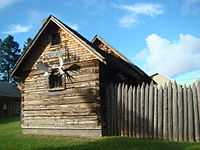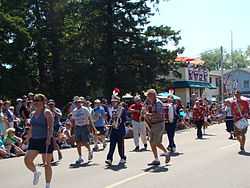Madeline Island


Madeline Island is an island located in Lake Superior. Part of Ashland County, Wisconsin, the island has a permanent population of 246. Although the largest of the Apostle Islands, it is not included in the Apostle Islands National Lakeshore. It is the only island in the Apostle Island chain open to commercial development and private ownership. The community of La Pointe, located on the western edge of the island, was one of the earliest settlements in the area.[2] The island can be accessed by ferry from nearby Bayfield.
History
Madeline Island is named after Madeleine Cadotte, daughter of Chief White Crane and wife of fur trader Michel Cadotte.[2] Inhabited by Native Americans, fur traders, and missionaries for over 400 years, it has flown the flags of three nations.[2]
Early settlers
Originally called Mooningwanekaaning ("The Home of the Golden Breasted Woodpecker"), the island was inhabited by the La Pointe Band of Lake Superior Chippewa, an Ojibwa band of the Lake Superior Chippewa.
The first white settlers were French fur traders, who in 1693 established the fort that eventually became the community of La Pointe. In the 18th century La Pointe became the site of an important post of the American Fur Company under Michel Cadotte, whose wife was Ikwesewe (Madeline), for whom the island was named.
Fur trade and early industry

Over a span of 150 years, Madeline Island was an important outpost for French, British and American fur traders.[2]
In about 1660, Radisson and Groseilliers, two explorers and fur traders, made their way to Chequamegon Bay. They started a French fur trading post on the island, which was then part of New France. The period from about 1660 through 1763 saw a fierce rivalry grow between France and Great Britain as each European power struggled to expand its fur trading territories in the North American fur trade.
The fur trade on the island later came under the control of the South West Company, which was the midwestern division of the American Fur Company, a company founded by John Jacob Astor in 1808.[3] By 1830 it is had grown to monopolize the fur trade in the United States.
The island's fur trading history has been preserved in the Madeline Island Historical Museum.
After the fall of the fur trade industry, other industries followed, including logging, commercial fishing, and brownstone quarrying. Apostle Island Brownstone was used to construct the first Milwaukee County Courthouse.
Today, the primary industry is tourism.
Early religious missions

Around 1665, Jesuit FatherClaude Allouez and Father Jacques Marquette arrived, and a mission was soon established.[2] Later, in 1835, Father Frederic Baraga established a Catholic mission on the Island, at the site of the La Pointe Indian Cemetery. Although the mission building is no longer extant, the old cemetery that remains is the burial place of Chief Buffalo, an important Chippewa leader.
Baraga's second Catholic mission on the island was built in 1838, on the site of the current St. Joseph's Catholic Church. With a congregation dating back to 1838, it is the oldest continuous Catholic parish in Wisconsin.[4] The original church building burned down in 1901 and was rebuilt in 1902.
A Protestant mission, known as "The Old Mission", dates back to 1832. The present La Pointe post office is half of the original "Old Mission" dining room, added to the Old Mission Inn in 1900, when it became a hotel.[5]
Today, the only Protestant church on the island is St. John's United Church of Christ,[6] built in 1925.
Native American significance
Madeline Island has been the traditional spiritual center of the Lake Superior Chippewa. An Anishinaabe legend says that Great Spirit Gitche Manitou told the people to travel west to the place where the "food grows upon the water", which led them to the wild rice that grew in the marshes in nearby Chequamegon Bay. Madeline Island was also the home of Chief Buffalo, who was instrumental in resisting the efforts of the U.S. government to remove the Chippewa and in securing permanent reservations under the Treaty of La Pointe of 1854 that remain today. The bulk of the Ojibway on Madeline Island resettled to the Bad River Reservation east of Ashland, however, Chief Buffalo was granted a tract for his family on the mainland just west of Madeline Island in what is now known as the Red Cliff Indian Reservation.
On the eastern end of the island is an exclave of the Bad River Indian Reservation of approximately 195 acres (0.79 km2).
Island life today
The island has a permanent population of 246, which does not include seasonal residents, according to the 2000 U.S. Census. The island's school educates children through 5th grade. Middle and high school-age students attend school in Bayfield.
Geography
The island is fourteen miles (21 km) long and three miles (5 km) wide. It is the only developed island of all the Apostle islands, although there are lighthouses on many of the islands and small, preserved fishing communities on a few (such as Stockton Island, Raspberry Island and Manitou Island).
The unincorporated community of La Pointe, Wisconsin, which is the main settlement in the Town of La Pointe, is located on the southwestern tip of the island, with Grant’s Point being the southeastern most point. The communities of Middleport and Old Fort are also located on the island.
Transportation

The island can be reached by ferry and airplane during the summer months. In the winter, the ice is usually too thick for ferry traffic. The last ferry runs of the season are typically in mid- to late January.
When ice conditions allow, an ice road opens to vehicle traffic from Bayfield across the frozen surface to Madeline Island. The ice road is traditionally marked by Christmas trees and is officially an extension of County Highway H. If ice is too thin for automobile traffic, but too thick for ferry traffic, access to the island is by airplane, snowmobile, and windsled only. The windsled often operates in early winter and spring.
The island may also be accessed by private boat and private charter service.
Tourism and recreation

The major industry on Madeline Island is summer tourism. Because of the natural beauty of the area and an abundance of outdoor recreational opportunities, the island is a popular vacation spot for people from the Midwest.
Activities
Hiking and biking are popular activities. Bicycles and mopeds are available for rent, as well as kayaks and canoes, for exploring the underwater caves and hollows of the cliff faces. The island is renowned for its beautiful beaches on Lake Superior. Swimming is a less frequent activity because of the low water temperatures, although the beaches are a popular destination during the summer. The surface water temperature in the sheltered bay can rise to 70 °F (21 °C) while the water just off shore might remain an at 50 degrees.
Fishing and sailing are popular activities. The Madeline Island Marina is the home of the Madeline Island Yacht Club.
The golf club sports a course designed by Robert Trent Jones that features double greens.
Madeline Island is also a popular place for summer weddings and honeymoons.
The Apostle Islands Cruise Service provides tours of the Apostle Islands National Lakeshore, including the historic Apostle Islands Lighthouses.
Accommodations

There are campsites in Big Bay State Park, a 2,350-acre (9.5 km2) park operated by the Wisconsin Department of Natural Resources on the south-central shore of the island.[7] The park is sometimes called Eagles' Nest for the bald eagles that make their nests in the tall pine trees on the cliffs. It encloses a large lagoon and a bog/dune ecosystem.
Big Bay Town Park, which adjoins the state park, also offers camping and provides access to the longest beach on the island.[8]
Other accommodations on the island include a motel and rental cabins.
Sites of interest
The Madeline Island Historical Museum, operated by the Wisconsin Historical Society, exhibits the history of the island. The original museum is four historic log structures that were relocated and joined together, along with a modern addition that houses historical artifacts.[9]
La Pointe Indian Cemetery, located next to the modern-day boat marina, is a historical cemetery that was the site of the first Catholic mission on the island in 1835.
Joni's Beach is a public beach, picnic and playground area.
Madeline Island Music Camp Clubhouse is an International Music Camp performance venue.
The Ojibwe National Prayer Pole/Memorial Park is an area containing sacred trees surrounding a pond, honoring the relationship between Ojibwe people and Madeline Island.
The Michel Cadotte Fur Trading Post of 1792, commemorated by a stone and brass plaque, is two miles from the ferry dock on private property.
In popular culture
Many legends and myths involving the island have added to the mystique of the place, especially in and around the Chequamegon Bay region. Fascination with the history of the island has helped fuel this phenomenon.[10]
In the book Badger Boneyards, author Dennis McCann discusses the history of the La Pointe Indian Cemetery,[11] and how it has sparked the imagination of people over the decades. Other sources mention rumors of paranormal activity associated with the cemetery, such as spirits of Ojibwe people.[12]
The island has been the backdrop of a number of novels, including Moon Over Madeline Island by Jay Gilbertson.
Riding the Wind is a musical production that portrays Bayfield and Old La Pointe, as told through story and song. It has appeared at the Lake Superior Big Top Chautauqua, an outdoor musical venue located south of Bayfield.[13]
Notable residents
- Michel Cadotte, prominent fur trader
- Kechewaishke, Native American leader
- Ozhaguscodaywayquay, noted Native American businesswoman
- Thomas D. O'Brien, Justice of the Minnesota Supreme Court
- William Whipple Warren, Minnesota Territory legislator
See also
- Populated islands of the Great Lakes
- List of islands of the United States
- Islands of the Great Lakes
- French Island and Washington Island, other populated islands in Wisconsin
References
- ↑ Madeline Island Ferry Line. "The Bayfield to La Pointe Connection". Retrieved July 26, 2013.
- ↑ 2.0 2.1 2.2 2.3 2.4 "Madelineisland.com". Retrieved 14 July 2013.
- ↑ Ingham, John M. (1983). Biographical dictionary of American business leaders. Westport, Conn: Greenwood Press. pp. 26–27. ISBN 0-313-23907-X.
- ↑ Lucero, Sam (2005). Our Journey Through Faith. Dr. Claude Costecalde. p. 116.
- ↑ "Northwestwisconsin.com". Retrieved 14 July 2013.
- ↑ "Madeline Island Chamber of Commerce". Retrieved 27 July 2013.
- ↑ "Wisconsin DNR". Retrieved 14 July 2013.
- ↑ "Big Bay Town Park". Retrieved 14 July 2013.
- ↑ "Madeline Island Museum". Retrieved 14 July 2013.
- ↑ "Bayfield Chamber of Commerce". Retrieved 14 July 2013.
- ↑ Badger Boneyards. Wisconsin Historical Society Press. pp. 134–134. ISBN 978-0-87020-451-7.
- ↑ "Wisconsinosity.com". Retrieved 14 July 2013.
- ↑ "Big Top Chataqua". Retrieved 14 July 2013.
External links
- Madeline Island Chamber of Commerce
- Madeline Island from Wisconsin Historical Society
- Madeline Island Ferry Line
- Big Bay State Park
- Over to Old La Pointe
| ||||||||||||||||||||||||||
Coordinates: 46°48′59″N 90°41′21″W / 46.81639°N 90.68917°W

